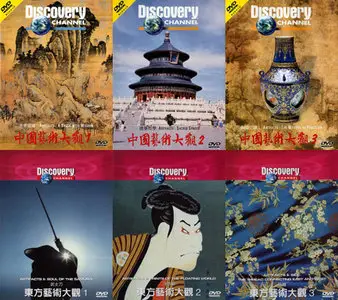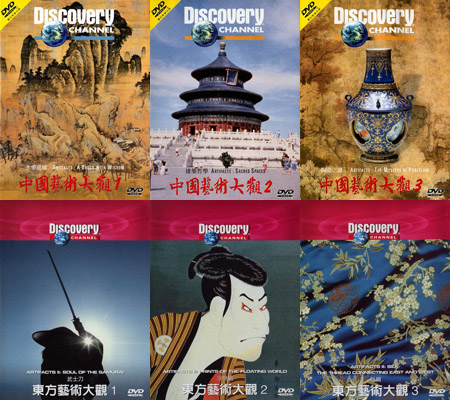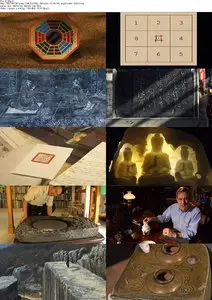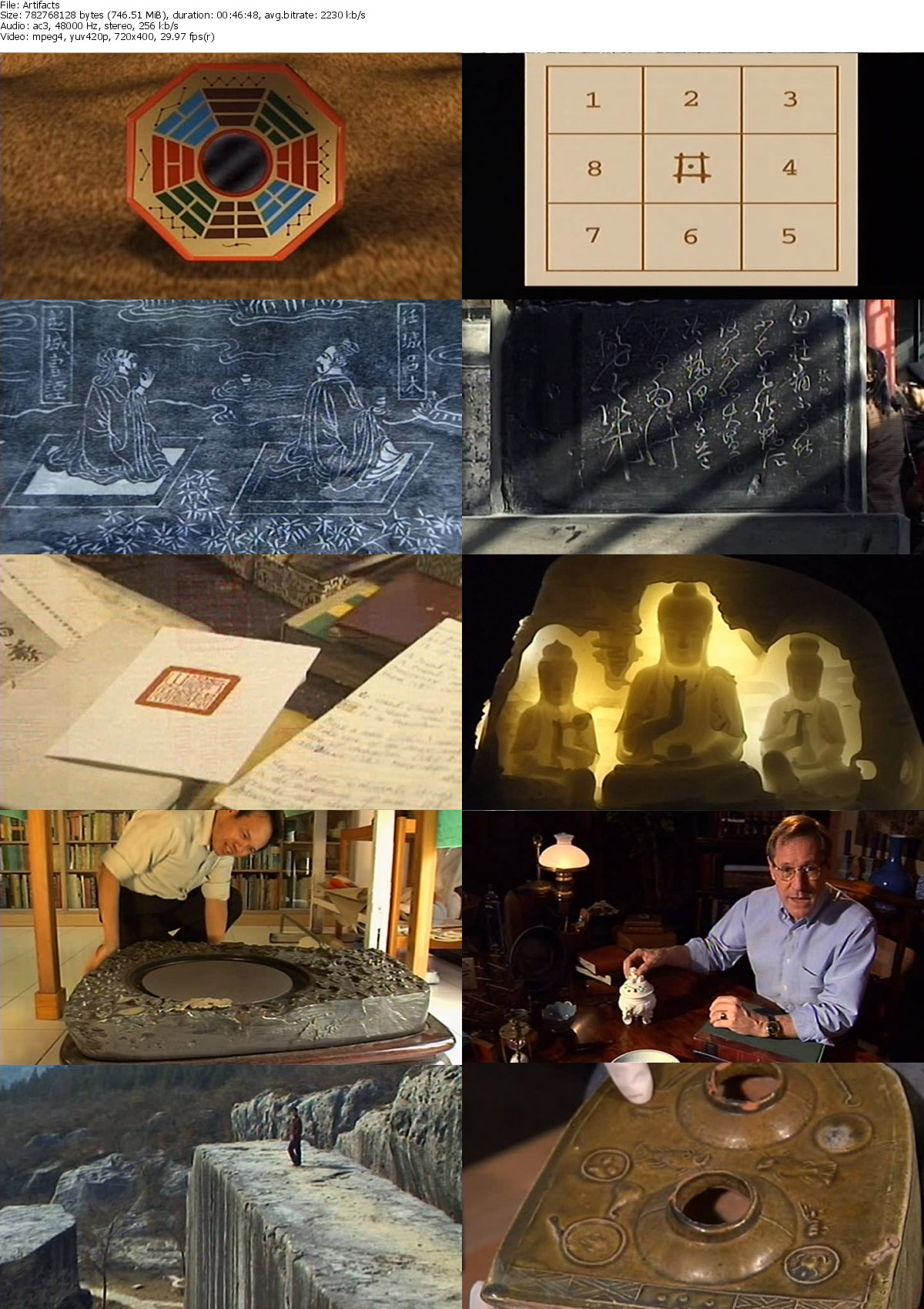Discovery Channel - Artifacts, all parts (2007)
DVD-Rip | AVI | English | Subtitles: English, Chinese, Portuguese | 47mn part | 720x400 29.97fps | XviD - 1950 kbps | AC3 - 256 kbps | 6x750 MB
Genre: Documentary
DVD-Rip | AVI | English | Subtitles: English, Chinese, Portuguese | 47mn part | 720x400 29.97fps | XviD - 1950 kbps | AC3 - 256 kbps | 6x750 MB
Genre: Documentary
How did an Indian Buddhist shrine influence a Japanese pagoda? How are Italian pigs and cowry shells related to porcelain? Why did the ferocious warriors of Mongolia wear silk underwear? And how did wood block printing bring about a revolution in Japan and in European culture? These intriguing questions are investigated in Artifacts, a series that explores the origins and hidden connections among the art and artifacts of the great cultures and belief systems across Asia - on a journey through time and across continents from India to Thailand, China and Japan - to understand the impact of calligraphy, porcelain, architecture, metallurgy, wood block printing and silk on Asian history and on the history of the world in general.
1. A Brush with Wisdom
When Westerners first discovered Chinese paintings, they could not see their value. They wouldn't even acknowledge them as art. But, as Confucius noted, it is possible to look without seeing. If you learn to see beyond the surface of these paintings, you will discover their real beauty and find the deepest truths of the Chinese philosophies of life. Enter the hidden world of Chinese painting. What makes a Chinese painting so distinctive, so immediately recognizable as Chinese? Is it the subject matter that Chinese artists chose to paint? Is it the different tools and techniques that they used? Or is it how they saw what they were looking at? How do we begin to understand this unique painting tradition which has survived virtually unchanged for so many centuries? Well, in China, they say to understand painting you need to understand calligraphy - the art of writing Chinese characters with a brush.
2. Sacred Spaces
A very long time ago, far away in China, a villager living along the banks of the Yellow River built a simple mud hut to shelter his family. Thousands of years later in the year 1420, the empire's best craftsmen put the final touches on the ultimate masterpiece of Chinese architecture - the Temple of Heaven. Chinese buildings evolved from simple shelters into complex, magnificent structures with great, swooping roofs, stately columns, and rich detail. Between this simple mud hut and this amazingly complex structure - its every detail full of cosmological symbolism - is a tale of emperors, monks, scholars and genius craftsmen - a story which explains an architectural tradition of great beauty and flexibility. And to start this story at the beginning, we have to leap back two millennia, to when the brilliant tyrant Qin Shihuang becomes the first emperor of a unified China.
3. The Mystery of Porcelain
When pieces of Chinese porcelain were first seen in the West, they were so rare and exquisite that they very quickly became more valuable than gold. Why? Because Europeans really had no idea how porcelain was made, and the medieval Italian merchants who first brought porcelain to Europe couldn't believe it was man made. The only thing that they could compare it to was a cowry shell, because a cowry shell has that same exquisite smooth surface as a piece of porcelain. In Italian, a cowry shell is called a "Porcellino" - a little pig - because it kind of looks like a little suckling pig, hence our word 'porcelain'. The Europeans were immediately obsessed with the secret of porcelain manufacture, leading to all kinds of crazy theories: Some thought it was crushed eggshells; others thought it was a special fish paste, which they would leave to ripen in the earth for one hundred years. No wonder it would be centuries before Europeans would even begin to unravel the great mystery of porcelain. It took the Chinese themselves thousands of years to discover the secret of porcelain - the product of a search for perfection which began more than six millennia ago.
4. Soul of the Samurai
Why has the samurai sword always been such a powerful symbol of Japanese culture? Dr. Inazo Nitobe, the man pictured on Japan's 5,000-yen note, tried to answer that question for the world. As a Japanese diplomat at the League of Nations, he was asked by a western colleague how - without religious instruction - the Japanese could teach their children right from wrong. So in the year 1900, Dr. Nitobe wrote a book in English called Bushido - the code of the samurai. He wrote that this warrior code became the credo by which most Japanese lived their lives. And, he wrote, just as the code of the samurai is the soul of Japan, the sword is the soul of the samurai. For Dr. Nitobe, the sword is a work of art that represents the soul of the samurai. But originally the sword was not the samurai's weapon of choice. In the beginning, they fought from horseback, and their skill was with the bow and arrow. So why did the sword, not the bow and arrow, become so important to the samurai and to Japan? To find the answer we must go deep into the history and legends of this ancient land.
5. Prints of the Floating World
Today's Japan. Everywhere you look, amazing images fight for your attention. This is the graphic art for which Japan is justly famous. It's an art which has it's roots in one of the most dynamic periods of Japan's past, the age of the woodblock print, or 'Ukiyo-e', an art form whose impact was as revolutionary in Japan as Gutenberg's printed books were in the west. While the paintings of the impressionists Monet, Van Gogh, and Degas are glittering treasures of western culture, their inspiration wasn't western at all. The real source of their new vision was not in France, not even in Europe, but in a country on the other side of the world - Japan! In the bustling capital city of Edo, later to be known as Tokyo, most woodblock prints were things to be admired and then thrown away like comics books or newspapers today. And so discarded prints were sometimes used to pack ceramics for export to America and Europe. This is how Japanese woodblock prints first found their way into the oriental curiosity shops of London and Paris. Initially, they went almost unnoticed among the Asian artifacts flooding into Europe. But when these brightly colored prints were discovered by the art world, exhibitions were quickly organized, and they would rock the foundations of Western Art.
6. Silk: The Thread Connecting East and West
Beautiful, smooth, soft, delicate, strong, and precious: silk. This amazing fabric has captivated human imagination for over 2000 years. Throughout history, it has clothed the rich and powerful. But more than this, it has been a form of currency, a tool of diplomacy, a badge of rank, and a fabric of the divine. And silk, above all other treasures, has been the thread connecting East and West. It is an artifact that has truly shaped history. The discovery of silk is said to have taken place in China almost two and a half thousand years ago by the wife of the "yellow emperor", Huang Di. Legend has it that the lady H'si Ling made her discovery when a silk moth cocoon fell from a mulberry tree into her hot tea where it began to unravel. The empress has been revered ever since as "the lady of silk" who taught the Chinese to cultivate mulberry trees and raise silk worms. Her discovery of the secret of silk would profoundly influence the history of China and the world.
Part 1. A Brush with Wisdom
http://www.wupload.com/file/68...h.Wisdom.avaxhome.ws.part1.rar
http://www.wupload.com/file/68...h.Wisdom.avaxhome.ws.part2.rar
http://www.wupload.com/file/68...h.Wisdom.avaxhome.ws.part3.rar
Part 2. Sacred Spaces
http://www.wupload.com/file/68...d.Spaces.avaxhome.ws.part1.rar
http://www.wupload.com/file/68...d.Spaces.avaxhome.ws.part2.rar
http://www.wupload.com/file/68...d.Spaces.avaxhome.ws.part3.rar
Part 3. The Mystery of Porcelain
http://www.wupload.com/file/68...orcelain.avaxhome.ws.part1.rar
http://www.wupload.com/file/68...orcelain.avaxhome.ws.part2.rar
http://www.wupload.com/file/68...orcelain.avaxhome.ws.part3.rar
Part 4. Soul of the Samurai
http://www.wupload.com/file/68...e.Samuraiavaxhome.ws.part1.rar
http://www.wupload.com/file/68...e.Samuraiavaxhome.ws.part2.rar
http://www.wupload.com/file/68...e.Samuraiavaxhome.ws.part3.rar
Part 5. Prints of the Floating World
http://www.wupload.com/file/68...ng.World.avaxhome.ws.part1.rar
http://www.wupload.com/file/68...ng.World.avaxhome.ws.part2.rar
http://www.wupload.com/file/68...ng.World.avaxhome.ws.part3.rar
Part 6. Silk: The Thread Connecting East and West
http://www.wupload.com/file/68...g.East.and.West.port.part1.rar
http://www.wupload.com/file/68...g.East.and.West.port.part2.rar
http://www.wupload.com/file/68...g.East.and.West.port.part3.rar
http://www.wupload.com/file/68...h.Wisdom.avaxhome.ws.part1.rar
http://www.wupload.com/file/68...h.Wisdom.avaxhome.ws.part2.rar
http://www.wupload.com/file/68...h.Wisdom.avaxhome.ws.part3.rar
Part 2. Sacred Spaces
http://www.wupload.com/file/68...d.Spaces.avaxhome.ws.part1.rar
http://www.wupload.com/file/68...d.Spaces.avaxhome.ws.part2.rar
http://www.wupload.com/file/68...d.Spaces.avaxhome.ws.part3.rar
Part 3. The Mystery of Porcelain
http://www.wupload.com/file/68...orcelain.avaxhome.ws.part1.rar
http://www.wupload.com/file/68...orcelain.avaxhome.ws.part2.rar
http://www.wupload.com/file/68...orcelain.avaxhome.ws.part3.rar
Part 4. Soul of the Samurai
http://www.wupload.com/file/68...e.Samuraiavaxhome.ws.part1.rar
http://www.wupload.com/file/68...e.Samuraiavaxhome.ws.part2.rar
http://www.wupload.com/file/68...e.Samuraiavaxhome.ws.part3.rar
Part 5. Prints of the Floating World
http://www.wupload.com/file/68...ng.World.avaxhome.ws.part1.rar
http://www.wupload.com/file/68...ng.World.avaxhome.ws.part2.rar
http://www.wupload.com/file/68...ng.World.avaxhome.ws.part3.rar
Part 6. Silk: The Thread Connecting East and West
http://www.wupload.com/file/68...g.East.and.West.port.part1.rar
http://www.wupload.com/file/68...g.East.and.West.port.part2.rar
http://www.wupload.com/file/68...g.East.and.West.port.part3.rar
Part 1. A Brush with Wisdom
http://www.filesonic.com/file/...h.Wisdom.avaxhome.ws.part1.rar
http://www.filesonic.com/file/...h.Wisdom.avaxhome.ws.part2.rar
http://www.filesonic.com/file/...h.Wisdom.avaxhome.ws.part3.rar
Part 2. Sacred Spaces
http://www.filesonic.com/file/...d.Spaces.avaxhome.ws.part1.rar
http://www.filesonic.com/file/...d.Spaces.avaxhome.ws.part2.rar
http://www.filesonic.com/file/...d.Spaces.avaxhome.ws.part3.rar
Part 3. The Mystery of Porcelain
http://www.filesonic.com/file/...orcelain.avaxhome.ws.part1.rar
http://www.filesonic.com/file/...orcelain.avaxhome.ws.part2.rar
http://www.filesonic.com/file/...orcelain.avaxhome.ws.part3.rar
Part 4. Soul of the Samurai
http://www.filesonic.com/file/...e.Samuraiavaxhome.ws.part1.rar
http://www.filesonic.com/file/...e.Samuraiavaxhome.ws.part2.rar
http://www.filesonic.com/file/...e.Samuraiavaxhome.ws.part3.rar
Part 5. Prints of the Floating World
http://www.filesonic.com/file/...ng.World.avaxhome.ws.part1.rar
http://www.filesonic.com/file/...ng.World.avaxhome.ws.part2.rar
http://www.filesonic.com/file/...ng.World.avaxhome.ws.part3.rar
Part 6. Silk: The Thread Connecting East and West
http://www.filesonic.com/file/...g.East.and.West.port.part1.rar
http://www.filesonic.com/file/...g.East.and.West.port.part2.rar
http://www.filesonic.com/file/...g.East.and.West.port.part3.rar
http://www.filesonic.com/file/...h.Wisdom.avaxhome.ws.part1.rar
http://www.filesonic.com/file/...h.Wisdom.avaxhome.ws.part2.rar
http://www.filesonic.com/file/...h.Wisdom.avaxhome.ws.part3.rar
Part 2. Sacred Spaces
http://www.filesonic.com/file/...d.Spaces.avaxhome.ws.part1.rar
http://www.filesonic.com/file/...d.Spaces.avaxhome.ws.part2.rar
http://www.filesonic.com/file/...d.Spaces.avaxhome.ws.part3.rar
Part 3. The Mystery of Porcelain
http://www.filesonic.com/file/...orcelain.avaxhome.ws.part1.rar
http://www.filesonic.com/file/...orcelain.avaxhome.ws.part2.rar
http://www.filesonic.com/file/...orcelain.avaxhome.ws.part3.rar
Part 4. Soul of the Samurai
http://www.filesonic.com/file/...e.Samuraiavaxhome.ws.part1.rar
http://www.filesonic.com/file/...e.Samuraiavaxhome.ws.part2.rar
http://www.filesonic.com/file/...e.Samuraiavaxhome.ws.part3.rar
Part 5. Prints of the Floating World
http://www.filesonic.com/file/...ng.World.avaxhome.ws.part1.rar
http://www.filesonic.com/file/...ng.World.avaxhome.ws.part2.rar
http://www.filesonic.com/file/...ng.World.avaxhome.ws.part3.rar
Part 6. Silk: The Thread Connecting East and West
http://www.filesonic.com/file/...g.East.and.West.port.part1.rar
http://www.filesonic.com/file/...g.East.and.West.port.part2.rar
http://www.filesonic.com/file/...g.East.and.West.port.part3.rar
Add 3% Recovery Record. No password





